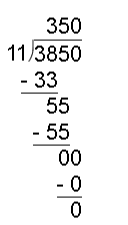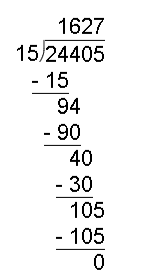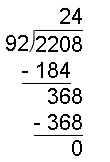Word Problem: Division - 1 | Mathematics for Class 4 PDF Download

Q1. How many chocolates does each child receive if 6 children share 12 chocolates?
Ans: Total number of chocolates = 12
Number of children = 6
So, to find out number of chocolates each child gets, we divide 12 by 6
Number of chocolates each child gets = 12 ÷ 6 = 2
Therefore, each child gets 2 chocolates.
Q2. There are 18 apples. Jon arranges them on 3 plates. How many apples are there in each plate?
Ans: Number of apples = 18 apples
Number of plates = 3 plates
To find out the number of apples that should be in each plate, we need to divide the total number of apples by the number of plates
Number of apples in each plate = 18 ÷ 3 = 6
This means that Jon should put 6 apples in each of the 3 plates to distribute them equally.
Q3. The train fare for 11 persons was Rs 3850. What was the fare for one person?
Ans: Number of persons = 11
Total fare for 11 persons = Rs 3850
Fare for one person = 3850 ÷ 11 = Rs 350
Thus the fare for one person in train is Rs 350
Q4. The cost of 15 cycles is Rs 24,405. Find the cost of each cycle.
Ans: Number of cycles = 15
Total cost of 15 cycles = Rs 24,405
Cost of each cycle = 24,405 ÷ 15 = Rs 1627
Therefore each cost of each cycle is Rs 1627.
Q5. Rs 5,876 is distributed equally among 26 men. How much money will each person get?
Ans: Money received by 26 men = Rs 5876
So, money received by one man = 5876 ÷ 26 = Rs 226
Therefore, each man received Rs 226
Q6. How many hours are there in 1200 minutes?
Ans: We know that there are 60 minutes in 1 hour
Number of hours in 1200 minutes = 1200 ÷ 60 = 20 hours
So there are 20 hours in 1200 minutes
Q 7. Mark baked 195 cookies and divided them equally into 13 packs. How many cookies did Mark put in each packet?
Ans: Total number of cookies baked by Mark= 195
Number of packs = 13
Number of cookies put by Mark in each packet = 195 ÷ 13
Therefore, the number of cookies put in each packet is 15.
Q8. At a grand sale, CDs are on sale for Rs 5. How many CDs can James buy if he has a Rs 635 bill?
Ans: Cost of each CD = Rs 5
Total bill of James = Rs 635
Number of CDs James bought = 635 ÷ 5
Therefore, James bought 127 CDs.
Q9. In a class, the teacher gave his six students 108 Rupees to share equally. How much money did each student get?
Ans: Number of students who got the money = 6
Total amount of money given by teacher = Rs 108
Amount of money each student will get = 108 ÷ 6
Therefore, each student will get 18 Rupees.
Q10. 92 bags of cement can be loaded in a truck. How many such trucks will be needed to load 2208 bags?
Ans: Number of cement bags that can be loaded in one truck = 92 bags
Total numbers of cement bags that are to be loaded = 2208 bags
Number of trucks that are required to load 2208 bags = 2208 ÷ 92 = 24
Therefore, 24 trucks are required.
|
33 videos|168 docs|30 tests
|
FAQs on Word Problem: Division - 1 - Mathematics for Class 4
| 1. What is division in mathematics? |  |
| 2. How do I solve a division problem? |  |
| 3. What are some real-life applications of division? |  |
| 4. What is the relationship between division and multiplication? |  |
| 5. What strategies can help with learning division? |  |
































